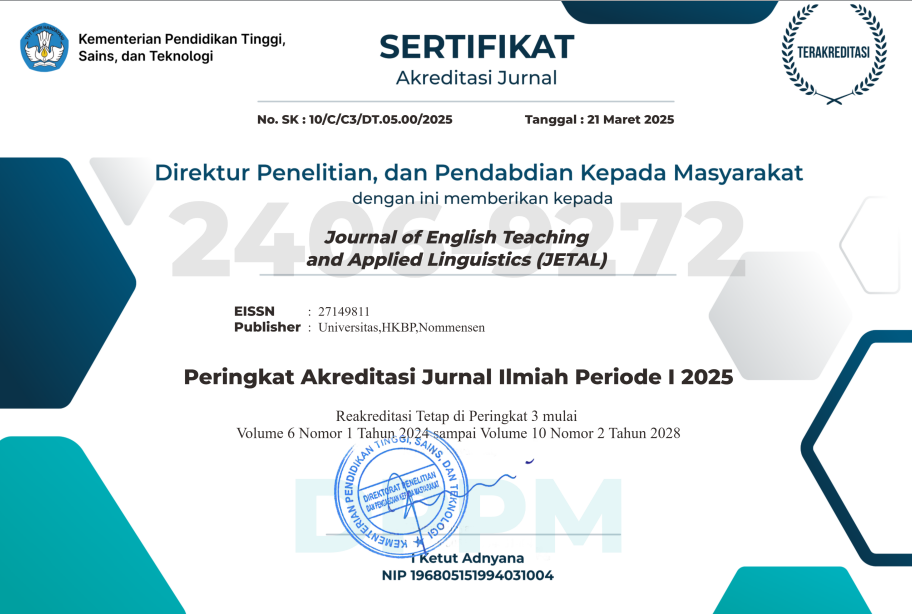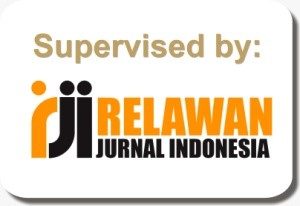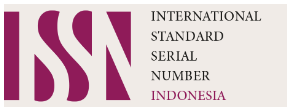Effective Vocabulary Teaching Techniques for EFL Teachers in Primary Classrooms
Abstract
The aim of this study is to explore vocabulary teaching techniques applied by EFL teachers in primary schools in Depok, Indonesia. Using a qualitative case study approach, the study involved observations, semi-structured interviews, and document analysis as primary data collection methods. Three EFL female teachers from three primary schools in Depok participated in this research. The findings reveal that repetition drills and translation are the most commonly used strategies due to their effectiveness in vocabulary retention and comprehension. Visual aids and interactive activities like games also play a significant role, though their use is often limited by resource constraints, and large class sizes. The research suggests that combining traditional methods with innovative approaches can improve vocabulary teaching, but further support in terms of resources and professional development is necessary for teachers to maximize their effectiveness. The study recommends future research focusing on digital tools and technology-based interventions, assessing the impact of teacher training programs, and comparing urban and rural contexts. Additionally, exploring the long-term effects of these techniques on students’ language proficiency would provide valuable insights for enhancing English education in Indonesia.
References
Butler, Y. G. (2019). Teaching vocabulary to young secondor foreign-language learners What can we learn from the research? Language Teaching for Young Learners, 1(1), 4–33. https://doi.org/10.1075/ltyl.00003.but
Cameron, L. (2002). Reviews Teaching Languages to Young Learners. https://assets.cambridge.org/052177/3253/sample/0521773253WS.pdf. https://assets.cambridge.org/052177/3253/sample/0521773253WS.pdf
Creswell, J. W. (2013). QUALITATIVE INQUIRY & RESEARCH DESIGN (3rd ed., Vol. 21, Issue 1). Sage Publication, Inc. http://www.ceil-conicet.gov.ar/wp-content/uploads/2018/04/CRESWELLQualitative-Inquary-and-Research-Design-Creswell.pdf
Crystal, D. (2003). English as Global Language. In The Palgrave Handbook of Economics and Language (Second Edi). Cambridge University Press. https://doi.org/https://doi.org/10.1017/CBO9780511486999
Garton, S., Copland, F., & Burns, A. (2013). Investigating global practices in teaching English to Young Learners. In British Council ELT Research Papers Volume 1 (Issue January). http://englishagenda.britishcouncil.org/sites/ec/files/British Council WEB pdf_0.pdf
Gumartifa, A., Saputri, K., & Yuliani, S. (2020). The knowledge of vocabulary learning strategies practice for English as a second language learners. English Community Journal, 4(2), 79–89. https://doi.org/DOI: https://doi.org/10.32502/ecj.v4i2.3016
Heidari, K. (2020). Critical thinking and EFL learners’ performance on textually-explicit, textually-implicit, and script-based reading items. Thinking Skills and Creativity, 37(August), 100703. https://doi.org/10.1016/j.tsc.2020.100703
Kirkpatrick, A. (2007). World Englishes: Implications for international communication and English language teaching. In Cambridge University Press. Cambridge University Press. https://doi.org/10.1017/s0047404509990376
Lie, A. (2007). Education Policy and EFL Curriculum in Indonesia: Between the Commitment to Competence and the Quest for Higher Test Scores. TEFLIN Journal, 18(1), 1–14. https://doi.org/https://doi.org/10.15639/teflinjournal.v18i1/1-15
McKeown, M. G. (2019). Effective vocabulary instruction fosters knowing words, using words, and understanding how words work. Language, Speech, and Hearing Services in Schools, 50(4), 466–476. https://doi.org/10.1044/2019_LSHSS-VOIA-18-0126
Mendrofa, M., & Wijaya, M. (2022). Benefits of Drilling Repetition in Enhancing Second Language Learners’ Speaking Ability. International Journal of English and Applied Linguistics (IJEAL), 2(2), 263–270. https://doi.org/10.47709/ijeal.v2i2.1583
Mumary Songbatumis, A. (2017). Challenges in Teaching English Faced by English Teachers at MTsN Taliwang, Indonesia. Journal of Foreign Languange Teaching and Learning, 2(2). https://doi.org/10.18196/ftl.2223
Mupa, P., & Chinooneka, T. I. (2015). Factors Contributing to Ineffective Teaching and Learning in Primary Schools: Why are Schools in Decadence? Journal of Education and Practice, 6(19), 125–133. www.iiste.org
Nation, P. (2001). Learning Vocabulary in Another Language. Cambridge University Press. https://catdir.loc.gov/catdir/samples/cam031/2001269892.pdf
Nation, P. (2017). How vocabulary is learned. Indonesian Journal of English Language Teaching, 12(May), 1–14. https://doi.org/DOI: 10.25170/ijelt.v12i1.829
Norman, A. S., & King, R. J. (2020). Expanding Approaches for Research: Understanding and Using Trustworthiness in Qualitative Research. 26 JOURNAL of DEVELOPMENTAL EDUCATION, 44(1), 26–28. https://files.eric.ed.gov/fulltext/EJ1320570.pdf
Pajarwati, D., Mardiah, H., Harahap, R. P., Siagian, R. O., & Ihsan, M. T. (2021). Curriculum reform in Indonesia : English education toward the global compeitiveness. ETDG: Indonesian Journal of Research and Educational Review, 1(1), 28–36. https://doi.org/DOI: https://doi.org/10.51574/ijrer.v1i1.51
Palinkas, L. A., Horwitz, S. M., Green, C. A., Wisdom, J. P., Duan, N., Hoagwood, K., Angeles, L., & Northwest, K. P. (1968). "Dentists face added drug regulation. Dental Survey, 44(12), 73. https://doi.org/10.1007/s10488-013-0528-y.Purposeful
Pinter, A. (2017). Teaching Young Language Learners (Second Edi). Oxford University Press. https://www.scribd.com/document/527744258/Teaching-Young-Language-Learners-Second-Edition
Pratiwi, S. G., Fatimah, N., & Akhsan, N. R. (2021). Teachers’ Strategies in Teaching English to Young Learners in Private Primary Schools in Yogyakarta. Ahmad Dahlan Journal of English Studies, 8(2), 154. https://doi.org/10.26555/adjes.v8i2.19246
Schmitt, N. (2008). Review article: Instructed second language vocabulary learning. In Language Teaching Research (Vol. 12, Issue 3). https://doi.org/10.1177/1362168808089921
Sinambela, E., Siregar, R., & Pakpahan, C. (2023). Improving Students’ Ability in Using English with A Simple Translation: A Case on Elementary School Level. Jurnal Obsesi : Jurnal Pendidikan Anak Usia Dini, 7(3), 3267–3278. https://doi.org/10.31004/obsesi.v7i3.4647
Syafrizal, S., & Haerudin, H. (2018). the Implementation of Vocabulary Building Strategy in Teaching English Vocabulary To Young Learners. Jo-ELT (Journal of English Language Teaching) Fakultas Pendidikan Bahasa & Seni Prodi Pendidikan Bahasa Inggris IKIP, 5(1), 40. https://doi.org/10.33394/jo-elt.v5i1.2296
Thornburry, S. (2003). How To Teach Grammar, pearson Education Limited (J. Harmer (ed.)). pearson Education Limited. https://jonturnerhct.files.wordpress.com/2014/09/how-to-teach-grammar-scott-thornbury.pdf
Wahyuningsih, S., & Ziyana Untsa, F. (2023). English as Business Lingua Franca: Examining the Use of English in Indonesian Online Business. ELT-Lectura, 10(2), 96–104. https://doi.org/10.31849/elt-lectura.v10i2.13699
Yao, Y., & Du-Babcock, B. (2023). English as a Lingua Franca in Mainland China: An Analysis of Intercultural Business Communicative Competence. International Journal of Business Communication, 60(1), 3–23. https://doi.org/10.1177/2329488419898221
Yin, R. K. (2003). CASE STUDY RESEARCH Design and Methods. In Adoption Quarterly (Third Edit, Vol. 3, Issue 3). Sage Publication, Inc. https://doi.org/10.1300/J145v03n03_07

This work is licensed under a Creative Commons Attribution-ShareAlike 4.0 International License.
Authors retain copyright and grant the journal right of first publication with the work simultaneously licensed under a Creative Commons Attribution-ShareAlike 4.0 International License (CC BY-SA 4.0) that allows others to share the work with an acknowledgment of the work's authorship and initial publication in this journal.
Authors are able to enter into separate, additional contractual arrangements for the non-exclusive distribution of the journal's published version of the work (e.g., post it to an institutional repository or publish it in a book), with an acknowledgment of its initial publication in this journal.
Authors are permitted and encouraged to post their work online (e.g., in institutional repositories or on their website) prior to and during the submission process, as it can lead to productive exchanges, as well as earlier and greater citation of published work (See The Effect of Open Access).






